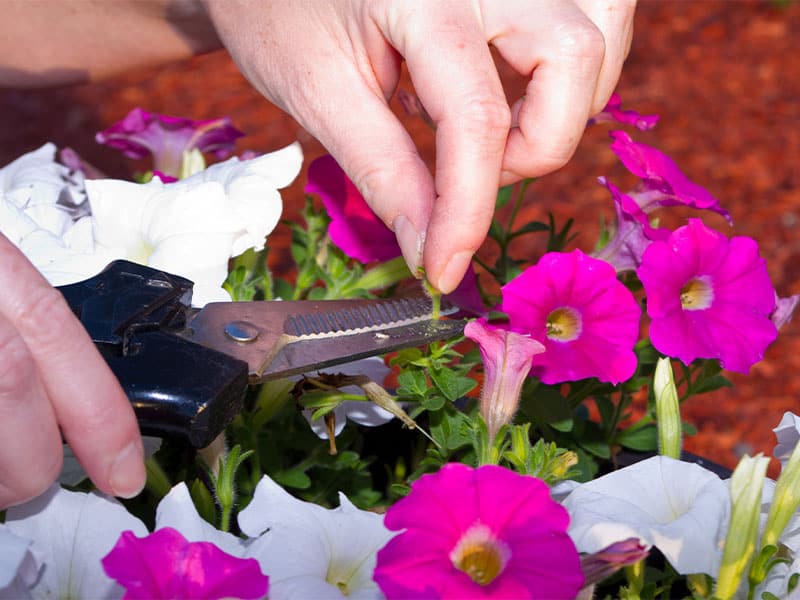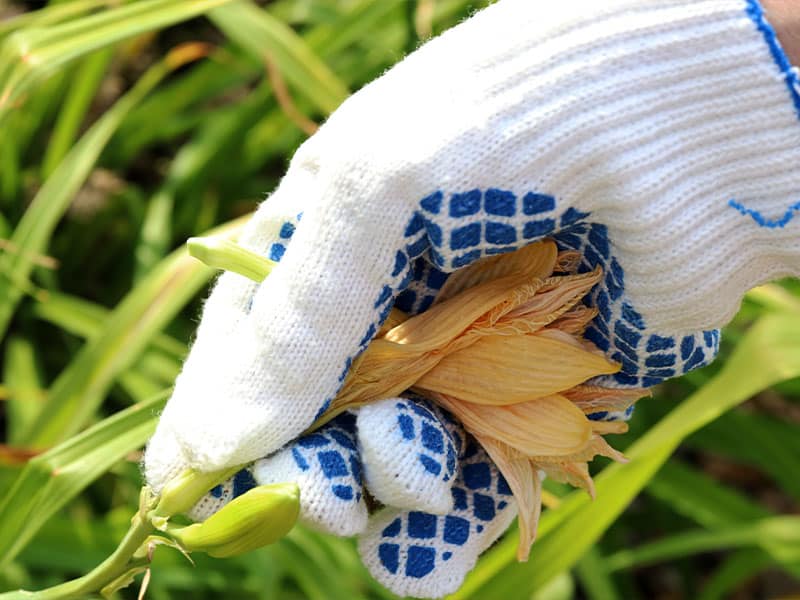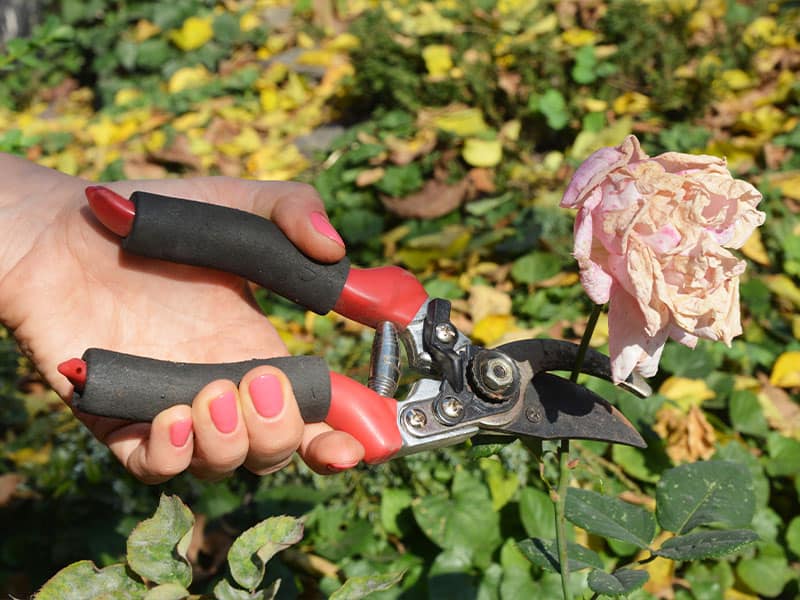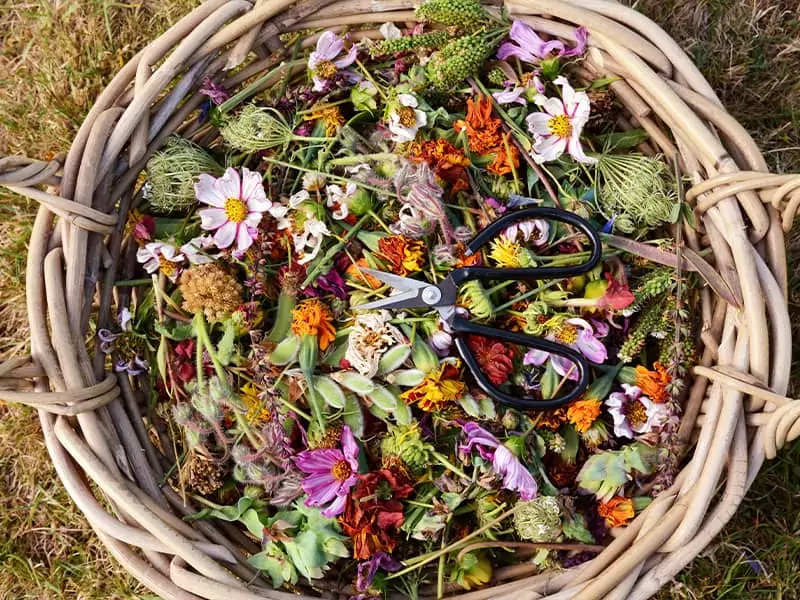Deadheading Flowers
You would be surprised how something so simple, such as deadheading flowers, can have such a tremendous impact on your garden.
Deadheading is easy, and many gardeners use this trick to prolong the blooming season or induce the second bloom. I will explain more about the process and help you learn why deadheading is useful.
You will learn how to do it properly and the optimal time for it.
Still, some plants don’t require deadheading and it can have the opposite effects on the plants. Keep reading to learn everything about deadheading flowers!
What is Deadheading Flowers?
Deadheading is a simple, yet effective gardening technique with plenty of benefits for your flowers. If you are new to gardening, don’t be intimidated by deadheading! It is very simple.
All you have to do is remove dead flowers from the plant. It will improve the plant’s look immediately. It also has benefits on the seed and affects the overall development of the plant. I will cover the benefits later in the article.
If you don’t do it regularly, it can be time-consuming, so try to make it a regular habit.
Some people deadhead their plants while on the phone or during watering, but you can come up with your own schedule that works the best for you.
Why Deadhead Your Flowers?
Flowers have more purposes than just making your garden look prettier. The nectar in flowers is food for bees, butterflies, and some birds and a habitat for plenty of wildlife species.
To understand why deadheading is important, let’s first understand the basic plant process. The plants strive for propagation, and the flowers are necessary for the life cycle of the plant. Once the blooming season is over, and the flowers pass, the plant focuses on creating seeds for further generations.
This part of the plant life cycle is the same for annual and perennial plants.
In the case of the flowering plants, removing dead flowers will re-invigorate the plant and possibly induce a second bloom, or more of them over the blooming season.
The Benefits of Deadheading
Deadheading is beneficial for the appearance of the plant and your garden but has more benefits when being a part of your standard garden routine.
Let’s take a closer look at the essential benefits of the deadheading of garden flowers.
Affect the Seed Formation
Some self-sowing plants are aggressive and they quickly overgrow their intended growing space. It can be an issue in smaller gardens. Deadheading prevents forming the seeds, so you can have better control over the plant.
Some of the aggressive self-sowing plants that can benefit from deadheading are chives, bellflowers, butterfly weed, and columbines.
Improve the Look of the Plant
After the blooming season, the dead flowers dry and turn brown, which look mushy and not aesthetically pleasing. The whole plant can look dead, and unattractive. When you remove the dead flowers, the plant appearance will improve, and it will look neater.
You can keep the tidy look of the garden if you deadhead all flowering plants in your garden.
Improve Setting Flower Buds
After the blooming season, the plant set seeds. So, the more flowers the plant has, the more seeds the plant will set. However, this rule doesn’t apply to all flowering plants.
Deadheading will prolong the blooming season and repeat it as long as you deadhead. For example, perennials such as Echinacea and Rudbeckia benefit from deadheading this way.
Improve the Plant Health
When you remove dead flowers, the plant will conserve energy and improve other aspects of its health.
Some perennial flowers, such as peonies and Astilbe, won’t bloom one more time, even when deadheaded.
But, if you remove the flower stalks, the plant will direct its energy into growing healthy roots and leaves. That way, it will become a hardier plant.
What to do First?
By now, you might be eager to implement deadheading, but there is one thing to do before you rush to your garden. Not all plants can benefit from deadheading, and deadheading can be harmful to some species.
For example, some perennial plants need to reseed after the first bloom to produce flowers next year. Therefore, first, check if your plant needs deadheading, and then learn how to do it properly.
Top 8 Plants to Deadhead
More plants can benefit from deadheading, but here is the list of eight most common plants in the gardens with tips on how to deadhead them.

Pieris
Pieris forms flower clusters and requires deadheading and looks prettier after it. All you have to do is cut back dead flower clusters up to healthy flower buds. Don’t wait until the clusters are completely dead. Waiting too long won’t have an impact on the ongoing blooming season. It will improve the fresh growth next year.
Buddleja
Buddleja is magnificent when blooming with its vivid rich flowers. Spent flowers will turn brown and won’t look nice in the garden. You can use pruning shears to deadhead flowers at the base of the stem. It will induce further blooms.
Peonies
Peonies look beautiful during the blooming season. You can easily spot old flowers on the plant as they disturb the whole appearance of the plant. You should cut old flowers just at the base, and it will prevent seed production.
Choisya Ternata
Choisya ternata is known as Mexican Orange bloom and has charming white flowers. The end of the blooming season is usually in June, and you can cut the clusters after you notice that the flowers turn brown.
Camellia
Camellia and other flowering shrubs such as lilacs, bloom only once during the season. Deadheading won’t produce the second bloom, but it will help the plant to remain healthy. After you deadhead it, the plant will produce beautiful foliage and a stronger root.
You can apply the pinching technique to remove old flowers as they start to fade.
Hebe
Deadheading hebes will prolong the blooming season and you will enjoy the lovely violet flowers longer. You can cut flowers to the base when you notice they are turning brown. Inspect the plant several times to maintain a healthy look.
Roses
Roses have the most benefits from deadheading. The perfect timing for deadheading roses is when the flowers get tatty. I recommend using pruning shears and gloves when deadheading roses. Generally, the sooner you deadhead the flowers, the earlier you will notice new ones. You can deadhead clusters or separate flowers.
Lavatera
Lavetaras are unique flowers with white petals that turn violet at a petal base. You can encourage your plant to continue to bloom if you remove the old flowers just before the plant starts to form the seed heads.
Top 8 Plants that Don’t Need Deadheading
If you aren’t ready to commit to deadheading, you will be happy to hear that there is a significant number of plants that don’t need it. I will mention some of the most common plants that you shouldn’t deadhead.
If the plants from your garden aren’t on any of the lists, make sure to research them further.
Vinca
Vinca is a delightful annual plant, and it doesn’t require deadheading because it drops the dead flower heads below.
It blooms all summer without your assistance.
Baptisia Australis
Baptisia Australis is welcome in all gardens because it produces stunning violet-blue flowers that are in contrast with dark foliage.
Similar to the previous plant, the Baptisia Australis starts blooming in the early summer and blooms until the end of the season.
Leave the flowers on the stems, because they will become purple pods.
Begonias
Begonias are easy-maintenance flowers, and they maintain themselves. Almost all species drop the old flowers and continue to bloom for long. They stay beautiful for months without the need for deadheading.
Astilbe
Astilbe looks stunning with flowers or without them. The older flowers slowly dry and give the plant a unique look of plums, and you don’t need to cut them.
Million Bells
Calibrachoa or Million bells doesn’t need to be deadheaded. It looks like a mini version of petunia and attracts butterflies. Deadheading this plant will be exhausting, and luckily the plant can take for itself!
Impatiens
Impatiens has stunning pink flowers, and it can clean itself. You don’t have to remove the old flowers manually, as the plant will do it.
Angelonia
Angelonia is available in different colors, and it is easy to grow. The plant requires simple maintenance and is self-cleaning.
The dead flowers and leaves slowly dry and disappear. But, the plant looks healthy during the time.
Nemesia
The bright plant Nemesia makes small clumps of mounds, covered by flowers. It is one of the most beautiful self-cleaning plants.
Plants that Require Occasional Deadheading
Some plants only need light deadheading. Those are Black-Eyed Susans, Geraniums, and several others.
Deadheading might not make them healthier or induce second bloom, but maintain the neat look of your garden.
Deadheading Methods
Now when you are familiar with the deadheading basics, let’s learn more about the deadheading methods.
Pruning
Pruning is convenient for plants with large flowers. Most gardeners who grow daylilies or coneflowers deadhead their plants using simple hand pruners.
You can remove the entire stalk from the plant base if every flower on the stalk is finished blooming. If you can notice unopened buds, only remove the dead flowers. Usually, dead flowers are on the top of the stalk, and buds are lower.
Shearing
Some plants, such as thread leaf coreopsis, have a lot of tiny flowers, and they require different treatment when deadheading. The best way to do it is to wait until a majority of the flowers are mature and shear the plant by approximately one-third. You will lose some of the new flowers, but the plant will regenerate quickly and award you with new blooms.
These plants are best to shear several times per season.
Pinching
Pinching is the easiest and simplest, tool-free deadheading method.
If you have plants with thin flower stalks, you can easily pinch the dead flowers off between two fingers.
This method is excellent for plants grown for their leaves, such as coleus.

How to Choose the Best Technique for Your Plants?
The technique depends on the plant itself. For example, if the plant is soft, you don’t need any tools, you can deadhead it with your hands by pinching.
Some plants have sturdy stems and require pruning at the base of the flower. You can always research more about the plant itself and see which methods prove to be the best for you.
Deadheading Annuals
Annual plants go to seed once their blooming season is complete.
If you don’t maintain the plant the natural process goes like this: bloom, fertilization, and setting the seeds.
In this life cycle, the plant utilizes all energy to set seed, and stop making new flowers. That is why deadheading annual plants will stop the process, and prevent setting the seeds too early.
You can pinch off dead flowers to train the plant to focus its energy and make more flowers.
The plant will have more flowers and a longer blooming season.
You can pinch the central tip of the plant to induce side shoots lower on the plant. That way, the plant will be bushier and prettier.
Once you complete the deadheading, you can fertilize the plant with water-soluble fertilizer 20-20-20.
Deadheading Perennials
The same idea stands behind deadheading perennials – training the plant to make more buds and flowers. However, some perennials, such as peonies, cannot produce more flowers after deadheading, but the plant will look healthier and become hardier after regular deadheading practice.
Most early-summer and spring bloomers don’t look pretty in mid-summer. For example, perennials Silver Mound Artemisia and Cranesbill Geraniums look gross after July. You want to keep the fresh look of your garden, don’t you?
After deadheading these plants, they will produce fresh foliage, which will boost the look. The plant will be an attractive part of your garden landscape.
Additionally, you can apply the pinching technique to Chrysanthemums that bloom in the fall. Other fall-blooming plants that look better after pinching are Aconitum, Monarda, Sedum, etc.
Don’t forget to apply fertilizer 20-20-20 after you deadhead your plants.
When to Deadhead your Plants?
Deadhead timing isn’t important, because it can happen anytime from spring to fall.
The easiest way to determine what the time is to deadhead the flowers is to inspect them. Once you notice the flowers are slowly fading, you can begin deadheading.
If you grow begonias and salvia, you can deadhead them after you notice that more than half of the flowers are fading.
The deadheading frequency depends on your plant and the weather conditions. Once the summer slowly turns into fall, you can stop deadheading and let the plant set seed.
How to Deadhead your Plants – Step by Step
Let’s go through every phase of deadheading which you can incorporate into your gardening routine. Some steps you can adjust according to your plants.
Choose the Cutting Point
The first step is the most complex one for beginners in the garden. For example, if you cut too close to the plant, the stem may dry and won’t recover.
The ideal spot for deadheading depends on the plant itself. There is a rule to follow – always cut dead flowers and stems to 1/4 of an inch above fresh, side flowers, leaves, or flower bud. It has been shown to have the best effects on producing new flowers and healthy leaves.
Cut
Cut or pinch the flower to the correct spot. If you are a beginner, I recommend using snips to deadhead most plants as they will produce a clean cut.
Most plants recover faster from tidy and precise cuts.
If you have to deadhead woody stems, for example, roses, you will need a stronger tool. Use pruning shears to make clean cuts.
Additionally, try to cut them at a 45-degree angle to reduce the risk of severe damage.
Clean Up
Once you deadhead your plants don’t forget to clean up. Collect the dead flowers from the ground. You can use a small bucket to collect them and place them in the compost pile.
Apply Fertilizer
Applying fertilizer will ensure continuous growth. Stick to your regular fertilizing schedule so the plants will grow healthy.
Your plants don’t need something fancy, the standard soluble fertilizer will provide necessary nutrients for the plants and help them to produce more blooms.
What to Avoid When Deadheading your Plants
Deadheading is an optional step in the gardening routine. If you have decided to do it, deadhead the plants properly, and you won’t harm the plants.
When you remove the seed heads, the plant will relocate its resource into developing healthy roots. Moreover, it will absorb more light and get hardier, to survive stress such as drought, heat, or low temperatures. It is important to do it properly to get the most benefits from deadheading.
Here is a shortlist of all the things you shouldn’t do when deadheading your plants. Researching the plant before any action is a must, so apply the following guide to your plants.
Don’t Be Afraid to Cut the Stem
Some flowers may look hideous if you cut only dead flowers and leave the bare stem. The long stem will stick out and make your plant look unattractive.
To avoid that, you can also cut the stem off at the bottom. It may take more time to grow the stem and flowers again, but it won’t harm the plant.
Don’t Deadhead the Plant with Developed Seed
I once had Gladwin iris in my backyard and it makes the seed pods in the early fall.
The seed pods are large, red, and attractive. So, I skipped deadheading Gladwin. If you like the plant with seed pods, you don’t have to deadhead it. Leave a couple of plants with seed pods in the early fall. That will make a charming announcement of the new season.
Don’t Make the Deadheading Primary Gardening Tasks
Deadheading is useful for your plants, but it may require additional maintenance such as applying fertilizer, fungicide, regular watering, etc. If you are super-busy and you don’t have time to inspect the flowers and deadhead them, the plants won’t die. If you forget to water your plants during drought, it may cause damage.
Don’t Deadhead the Plants during the Winter
Yes, you can deadhead flowers any time in the season. When the temperature drops, the birds and other species use the plant as their shelter. Seed pods are food for animals in the winter. Therefore, you can stop deadheading flowers at the beginning of the winter to help other wildlife in your garden.
Don’t Neglect New Offsprings
Sometimes, when you deadhead flowers, the seeds can settle in the ground. It will make new offspring pop out from the ground in places where you haven’t planted them. If these uncontrolled offsprings don’t bother you, let them grow.
Don’t Forget to Check the Plants Frequently
There are so many factors that affect deadheading frequency, including weather, soil, plant, etc.
Don’t just deadhead once after you notice the first flowers fade. Instead, check the flowers often whenever you have time for gardening.

What to do with Deadheaded Flowers?
After the first deadheading round in the garden, you might be wondering what to do with the dead flowers.
Once you pick up all debris you have just cut from the plant, you can put them in compost. That way, your dead flowers will actually do more good for the soil.

If you don’t want to turn the dead flowers into compost, you can deploy them into a trash bin.
When to Stop Deadheading the Plants
Even though deadheading prolongs the blooming season, you cannot do it indefinitely. When you stop deadheading the plant, it will go into dormancy for the upcoming winter.
It doesn’t apply to annuals, but perennial plants need to have time to store energy to survive winter.
Check the forecast and stop deadheading at least six weeks before the expected first frost.
You should stop deadheading annual plants in the fall to collect the seeds for the next year.
Leaving flowers on the plants such as roses and hydrangeas will make nutritious food for birds.
Deadheading – Easy Trick for Healthy Garden
In the end, deadheading isn’t difficult, and once you get used to it, it will become a natural practice to you. Make sure to check the plant’s preferences towards deadheading, and act accordingly.
Some plants benefit from deadheading, but others may suffer or don’t need deadheading at all.
Deadheading can help you keep the flourishing look of your garden, but it is also important for some plants to survive the winter and remain healthy.
Both annuals and perennials can be deadheaded, but it depends on the plant species.
Deadheading also produces enough organic debris for compost, so it is a well-embraced practice among gardeners around the world.
If you learn something new from the article, don’t forget to like it and share it with your friends and family.
Which plants do you have more in your garden – those who need to be deadhead or those who you mustn’t deadhead?

